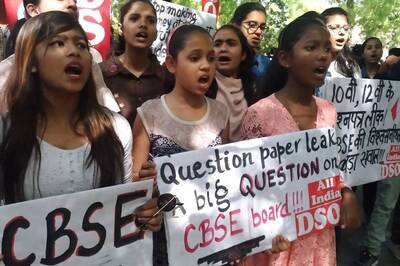
views
New Delhi: The number of stubble-burning events in Punjab, Haryana and the eight NCR districts of Uttar Pradesh has come down significantly this year, with a total of 1,795 such incidents reported this month as against 4,854 in the same period last year, the Centre's air quality commission said on Friday. The Commission for Air Quality Management (CAQM) in NCR and Adjoining Areas said according to a report based on the protocol framed by the ISRO, paddy residue-burning events have been reduced by 69.49 per cent in Punjab, 18.28 per cent in Haryana and 47.61 per cent in the eight NCR districts of Uttar Pradesh during a one-month period, as compared to the corresponding period last year.
"Active paddy residue-burning events in Punjab, Haryana and eight NCR districts of Uttar Pradesh have come down significantly this year, fewer fire counts reported in 2021 as compared to last year. "Total 1,795 fire counts reported for the one-month period till October 14 as against 4,854 instances reported in the corresponding period during 2020. Enforcement agencies have so far inspected 663 of the total reported sites in Punjab, Haryana and NCR districts of Uttar Pradesh," the commission said.
It said of the 1,795 sites from where stubble burning was reported in Punjab, Haryana and Uttar Pradesh, 663 fields have been inspected by the enforcement agencies and the officials concerned of the respective states and that an environmental compensation (EC) has been imposed in 252 cases. During the said period in the current year, 1,286 stubble-burning events were reported in Punjab as against 4,216 for the same period last year.
Haryana reported 487 such incidents as against 596 for the corresponding year last year. The total number of stubble-burning incidents reported from the eight NCR districts of Uttar Pradesh during this period was 22 as against 42 for the corresponding period last year.
No stubble-burning incident was reported from Delhi and the two NCR districts of Rajasthan. The first paddy residue-burning event was reported on September 16 in Punjab, on September 18 in the NCR area of Uttar Pradesh and on September 28 in Haryana.
In a statement, the CAQM said crop harvesting will be at its peak in the next few weeks and the state governments are taking steps in accordance with the plan of action to improve the efficacy of enforcement and implementation to effectively tackle the problem of stubble burning. To curb and abate air pollution during the ongoing harvest season, the CAQM has been actively monitoring paddy residue-burning events since September 15 in Punjab, Haryana and the eight NCR districts of Uttar Pradesh.
It has been regularly holding meetings with officials, including deputy commissioners, from Haryana, Punjab and Uttar Pradesh. A protocol has been developed by the Indian Space Research Organisation (ISRO) for the CAQM to monitor fire counts, in coordination with major stakeholders, including ICAR-IARI.
The commission is also monitoring the implementation of the action plan formulated by the governments of Punjab, Haryana and Uttar Pradesh, based on a framework developed by it for prevention and control of stubble burning. The hotspots of paddy residue-burning in Punjab are Amritsar, Tarn Taran, Patiala and Ludhiana. These four districts account for 72 per cent of the stubble-burning events in the state, the commission said.
Similarly, the hotspots in Haryana are Karnal, Kaithal and Kurukshetra. These three districts account for 80 per cent of the stubble-burning events in the state. The CAQM has also held a series of meetings with government officials, including district collectors and district Magistrates, of Punjab, Haryana and Uttar Pradesh.
.
Read all the Latest News , Breaking News and IPL 2022 Live Updates here.


















Comments
0 comment